- Home
- Jared Diamond
The Rise and Fall of the Third Chimpanzee Page 30
The Rise and Fall of the Third Chimpanzee Read online
Page 30
Geography sets ground rules for the evolution, both biological and cultural, of all species, including our own. Geography’s role in determining our modern political history is even more obvious than the role I have discussed in determining the rate at which we domesticate plants and animals. From this perspective, it is almost funny to read that half of all American schoolchildren do not know where Panama is, but not at all funny when politicians display comparable ignorance. Among the many notorious examples of disasters brought on by politicians ignorant of geography, two must suffice: the unnatural boundaries drawn on the map of Africa by nineteenth-century European colonial powers, thereby undermining the stability of some modern African states that inherited those borders; and the borders of Eastern Europe drawn at the Treaty of Versailles in 1919 by politicians who knew little of that region, thereby helping to fuel the Second World War.
Geography used to be a required subject in US schools and colleges until a few decades ago, when it began to be dropped from many curricula. The mistaken belief arose then that geography consisted of little more than memorizing the names of capital cities. But twenty weeks of geography in the seventh grade is not enough to teach our future politicians about the effects that maps really have on us. The fax machines and satellite communications that span the globe cannot erase the differences among us bred by differences in location. In the long run, and on a broad scale, where we live has contributed heavily to making us who we are.
FIFTEEN
HORSES, HITTITES, AND HISTORY
More than 4,000 years before the recent expansion of Europeans over all other continents, there was an earlier expansion within Europe and western Asia that sired most of the languages spoken in that region today. Although those earlier conquerors were illiterate, much of their language and culture can be reconstructed from shared word roots preserved in modern Indo-European languages. Their conquest of much of Eurasia, like the subsequent overseas expansion of their descendants, appears to have been an accident of biogeography.
*
‘YKSI, KAKSI, KOLME, neljä, viisi.’
I watched the little girl counting out five marbles, one by one. Her act was familiar, but her words were strange. Almost anywhere else in Europe, I would have heard words like our English ‘one, two, three’, ‘uno, due, tre’ in Italy, ‘ein, zwei, drei’ in Germany, ‘odin, dva, tri’ in Russia. But I was vacationing in Finland, and Finnish is one of Europe’s few non-Indo-European languages.
Today, most European languages and many Asian languages as far east as India are very similar to each other (see table of vocabulary overleaf). No matter how we complain while memorizing French word lists in school, these so-called ‘Indo-European’ languages resemble English and each other, and differ from all the world’s other languages, in vocabulary and grammar. Only 140 of the modern world’s 5,000 tongues belong to this language family, but their importance is far out of proportion to their numbers. Thanks to the global expansion of Europeans since 1492 – especially of people from England, Spain, Portugal, France, and Russia – nearly half the world’s present population of five billion now speaks an Indo-European language as its native tongue.
To us it may seem perfectly natural, and in no need of further explanation, that most European languages resemble each other. Not until we go to parts of the world with great linguistic diversity do we realize how weird is Europe’s homogeneity, and how it cries out for explanation. For example, in areas of the New Guinea highlands where I work and where first contact with the outside world began only in the Twentieth Century, languages as different as Chinese is from English replace each other over short distances (Chapter Thirteen). Eurasia must also have been diverse in its pre-first-contact condition, and gradually become less so until finally some people speaking the mother tongue of the Indo-European language family steamrollered almost all other European languages out of existence.
INDO-EUROPEAN VERSUS NON-INDO-EUROPEAN VOCABULARY
PIE stands for proto-Indo-European, the reconstructed mother tongue of the first Indo-Europeans. Foré is a language of the New Guinea Highlands. Note that most words are very similar among the Indo-European languages and totally different among the non-Indo-European languages.
Of all the processes by which the modern world lost its earlier linguistic diversity, the Indo-European expansion has been the most important. Its first stage, which long ago carried Indo-European languages over Europe and much of Asia, was followed by a second stage that began in 1492 and carried them to all other continents (Chapter Fourteen). When and where did the steamroller start, and what gave it its power? Why was Europe not overrun instead by speakers of a language related to, say, Finnish or Assyrian?
While the Indo-European problem is the most famous problem of historical linguistics, it is a problem of archaeology and history as well. In the case of those Europeans who carried out the second stage of the Indo-European expansion beginning in 1492, we know not only their vocabulary and grammar but also the ports where they set out, the dates of their sailings, the names of their leaders, and why they succeeded in conquering (Chapter Fourteen). But the quest to understand the first stage is a search for an elusive people whose language and society lie veiled in the pre-literate past, even though they became world conquerors and founded today’s dominant societies. That quest is also a great detective story, whose solution depends on a language discovered behind a secret wall in a Buddhist monastery, and on an Italian language inexplicably preserved on the linen wrappings of an Egyptian mummy.
When you first think about it, you might be excused for dismissing the Indo-European problem as obviously insoluble. Since the Indo-European mother tongue arose before the origin of writing, is it not almost by definition impossible to study? Even if we found the skeletons or pottery of the first Indo-Europeans, how would we recognize them? The skeletons and pottery of modern Hungarians, living in the centre of Europe, are as typically European as goulash is typically Hungarian. A future archaeologist excavating a Hungarian city would never guess that Hungarians speak a non-Indo-European language, if no examples of writing itself were recovered. Even if we could somehow locate the place and time of the first Indo-Europeans, how could we hope to deduce what advantage let their language triumph?
Remarkably, it turns out that linguists have been able to extract answers to these questions from the languages themselves. I shall explain why we are so confident that language distributions today reflect a steamroller in the past, then try to assess when and where the mother tongue was spoken, and how it managed to take over so much of the world.
*
How can we infer that the modern Indo-European languages replaced other, now-vanished languages? I am not talking about the observed second-stage replacements of the past 500 years, which saw English and Spanish dislodge most native tongues of the Americas and Australia. Those modern expansions were obviously due to the advantages Europeans gained from guns, germs, iron, and political organization (Chapter Fourteen). Instead, I am talking about the inferred first-stage replacement that saw Indo-European dislodge older languages of Europe and western Asia, and that must have happened before writing reached those areas.
The map on the following page shows the distribution of Indo-European language branches surviving in 1492, just before Spanish began to leap across the Atlantic with Columbus. Three branches are especially familiar to most Europeans and Americans: Germanic (including English and German), Italic (including French and Spanish), and Slavic (including Russian), each branch with twelve to sixteen surviving languages and 300 to 500 million speakers. The largest branch, however, is Indo–Iranian, with ninety languages and nearly 700 million speakers from Iran to India (including Romany, the language of gypsies). Relatively tiny surviving branches are Greek, Albanian, Armenian, Baltic (consisting of Lithuanian and Latvian), and Celtic (including Welsh and Gaelic), each with only two to ten million speakers. In addition, at least two Indo-European branches, Anatolian and Tocharian, vanished long ago
but are known from extensive preserved writings, while others disappeared with less trace.
LANGUAGE MAP OF EUROPE AND WESTERN ASIA
This map shows language distribution, circa 1492, just before the European discovery of the New World. There must have been other Indo-European language branches that had become extinct before then. However, lengthy written texts exist only in languages of the Anatolian branch (including Hittite) and the Tocharian branch, whose homelands became occupied by speakers of Turkic and Mongolian languages before 1492.
What proves that all these tongues are related to each other and distinct from other language stocks? One obvious clue is shared vocabulary, as illustrated by the table of vocabulary on here and thousands of other examples. A second clue is similar word endings (so-called inflectional endings) used to form verb conjugations and noun declensions. These endings are illustrated by part of the conjugation of ‘to be’ below. It becomes easier to recognize such similarities when you realize that word roots and endings shared between related languages are generally not shared identically. Instead, a particular sound in one language is often replaced by another sound in the other language. Familiar examples are the frequent equivalence of English ‘th’ and German ‘d’ (English ‘thing’ equals German ‘ding’, ‘thank’ equals ‘danke’), or of English ‘s’ and Spanish ‘es’ (English ‘school’ equals ‘escuela’, ‘stupid’ equals ‘estupido’).
Those resemblances among the Indo-European languages are detailed, but much grosser features of sounds and word formation set Indo-European languages apart from other language families. For example, my atrocious French accent embarrasses me as soon as I open my mouth to ask, ‘Où est le métro?’ But my difficulties with French are nothing compared with my total inability to produce the click sounds of some southern African languages, or to produce the eight gradations of vowel pitch in the Lakes Plain languages of the New Guinea lowlands. Naturally, my Lakes Plain friends loved teaching me bird names that differed only in pitch from words for excrement, then watching me ask the next villager I met for more information about that ‘bird’.
INDO-EUROPEAN VERSUS NON-INDO-EUROPEAN VERB ENDINGS:
TO BE OR NOT TO BE
Not only vocabulary, but also verb and noun endings, connect Indo-European languages and set them apart from other languages.
As distinctive to Indo-European as its sounds is its word formation. Indo-European nouns and verbs have various endings that we memorize assiduously when we learn a new language. (How many of you exscholars of Latin can still chant ‘amo, amas, amat, amamus, amatis, amant’?) Each such ending conveys several types of information. For example, the ‘o’ of ‘amo’ specifies first person singular present active: the lover is I, not my rival; one of me, not two of me; I am giving, not receiving, love; and I am giving it now, not yesterday. Heaven help the serenading lover who gets even a single one of those details wrong! But other languages, like Turkish, use a separate syllable or phoneme for each such type of information, while still other languages, like Vietnamese, virtually dispense with such variations of word form.
Given all these resemblances among Indo-European languages, how could the differences among them have arisen? A clue is that any language whose written documents span many centuries can be seen to change with time. For example, modern English-speakers find eighteenth-century English quaint but completely understandable; we can read Shakespeare (1564–1616), though we need notes to explain many of his words; but Old English texts, such as the poem Beowulf (circa 700–750 AD), are virtually a foreign language to us. A good example of how English has changed over the last 1,000 years is provided by the Twenty-Third Psalm:
MODERN (1989)
The Lord is my shepherd, I lack nothing.
He lets me lie down in green pastures.
He leads me to still waters.
KING JAMES BIBLE (1611)
The Lord is my shepherd, I shall not want.
He maketh me to lie down in green pastures.
He leadeth me beside the still waters.
MIDDLE ENGLISH (1100–1500)
Our Lord gouerneth me, and nothyng shal defailen to me.
In the sted of pasture he sett me ther.
He norissed me upon water of fyllyng.
OLD ENGLISH (800–1066)
Drihten me raet, ne byth me nanes godes wan.
And he me geset on swythe good feohland.
And fedde me be waetera stathum.
As speakers of one original language spread into different areas with limited contact, the independent changes of words and pronunciation in each area inevitably lead to different dialects, such as those that have arisen in different parts of the US in the few centuries since permanent English settlement began in 1607. With the passing of more centuries, dialects diverge to the point where their speakers can no longer understand each other and they now rank as distinct languages. One of the best documented examples of this process is the development of the Romance languages after the break-up of Latin around 500 AD. Surviving written texts from the Eighth Century onwards show us how the languages of France, Italy, Spain, Portugal, and Rumania gradually diverged from Latin – and from each other.
The derivation of the modern Romance languages from Latin thus illustrates how groups of related languages develop from a shared ancestral tongue. Even if we had no surviving Latin texts, we could still reconstruct much of the Latin mother tongue by comparing traits in its daughter languages today. In the same way, one can reconstruct a family tree of all the Indo-European language branches, based partly on ancient texts and partly on inferences. Hence language evolution proceeds by descent and divergence, just as Darwin demonstrated for biological evolution. In their languages as well as their skeletons, modern Englishmen and Australians, who began to diverge with the colonization of Australia in 1788, are much more similar to each other than either are to the Chinese, from whom they diverged tens of thousands of years ago.
Given time, the languages within any part of the world will keep on diverging, held back only by contacts between adjacent peoples. An example of the result is New Guinea, which had never been unified politically before European colonization, and where nearly one thousand mutually unintelligible languages – including dozens with no known relation to each other or to any other language in the world – are now spoken in an area the size of Texas. Thus, wherever you find the same language or related languages spoken over a wide area, you know that the clock of language evolution must have been restarted recently. That is, one language must have recently spread, eliminated other languages, and then started to differentiate all over again. Such a process accounts for the close similarities among southern Africa’s Bantu languages, and among Austronesian languages of Southeast Asia and the Pacific.
The Romance languages again provide our best documented example. As of 500 BC, Latin was confined to a small area around Rome and was only one of many languages spoken in Italy. The expansion of Latin-speaking Romans eradicated all those other languages of Italy, then eradicated entire branches of the Indo-European family elsewhere in Europe, like the continental Celtic languages. These sister branches were so thoroughly replaced by Latin that we know each of them only by scattered words, names, and inscriptions. With the subsequent overseas expansion of Spanish and Portuguese after 1492, the language spoken initially by a few hundred thousand Romans trampled hundreds of other languages out of existence, as it gave rise to the Romance languages spoken by half a billion people today.
If the Indo-European language family as a whole constituted a similar steamroller, we might expect to find its trampled debris in the form of older non-Indo-European languages surviving here and there. The sole such vestige surviving in Western Europe today is the Basque language of Spain, without known relations to any other language in the world. (The remaining non-Indo-European languages of modern Europe – Hungarian, Finnish, Estonian, and possibly Lapp – are relatively recent invaders of Europe from the east.) However, there were other
languages that were spoken in Europe until Roman times, and of which enough words or inscriptions have been preserved to identify them as non-Indo-European. The most extensively preserved of these vanished tongues is the mysterious Etruscan language of northwest Italy, for which we have a 281-line text written on a roll of linen that somehow ended up in Egypt as wrapping for a mummy. All such vanished non-Indo-European languages were part of the debris left from the Indo-European expansion.
Still more linguistic debris was swept up into the surviving Indo-European languages themselves. To understand how linguists can recognize such debris, imagine that you, as a freshly arrived visitor from outer space, were given one book each, written in English by an Englishman, an American, and an Australian, about his or her country.
The language and most of the words in all three books would be the same. But if you compared the American book with the one about England, the American book would contain many place names that were obviously foreign to the basic language of the books – names like Massachusetts, Winnepesaukee, and Mississippi. The Australian book would contain more place names equally foreign to the language but unlike the American names – such as Woonarra, Goondiwindi, and Murrumbidgee. You might guess that English immigrants coming to America and Australia encountered natives who spoke different languages, and from whom the immigrants picked up names for local places and things. You would even be able to infer something about the words and sounds of those unknown native languages. We actually know the native American and Australian languages from which those borrowings took place, and we can confirm that your indirect inferences from the borrowed words alone would have been correct.

 Why Is Sex Fun?: The Evolution of Human Sexuality
Why Is Sex Fun?: The Evolution of Human Sexuality Guns, Germs, and Steel: The Fates of Human Societies
Guns, Germs, and Steel: The Fates of Human Societies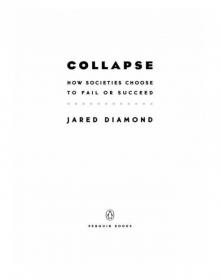 Collapse: How Societies Choose to Fail or Succeed
Collapse: How Societies Choose to Fail or Succeed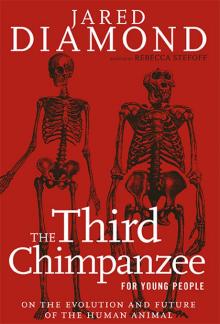 The Third Chimpanzee: The Evolution and Future of the Human Animal
The Third Chimpanzee: The Evolution and Future of the Human Animal The World Until Yesterday: What Can We Learn From Traditional Societies?
The World Until Yesterday: What Can We Learn From Traditional Societies?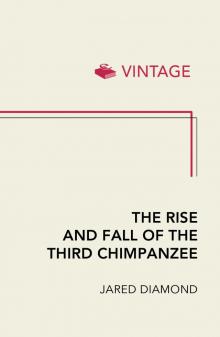 The Rise and Fall of the Third Chimpanzee
The Rise and Fall of the Third Chimpanzee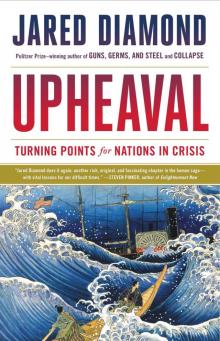 Upheaval: Turning Points for Nations in Crisis
Upheaval: Turning Points for Nations in Crisis Guns, Germs, and Steel
Guns, Germs, and Steel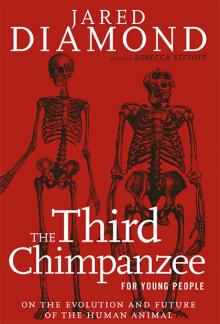 The Third Chimpanzee for Young People
The Third Chimpanzee for Young People Why Is Sex Fun?
Why Is Sex Fun?